Great Grapes
– Abigail Van Buren, “Dear Abby”
The foundation of most wine is the grape, but this small fruit has also long been used in many non-wine related products or as a stand alone snack. Thanks to the grape industry, many wineries were able to survive prohibition by selling grape juice and concentrated grape-derived products that could be legally converted to wine at home.
 |
Panorama taken from Italy Hill, Italy, N.Y., ca. 1935. [zoom] The hills near Canandaigua Lake and the Naples, N.Y. home of Widmer Wine Cellars are covered with their vineyards. |
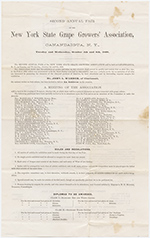 |
New York State Grape Grower’s Association. Event Flyer, 1869. [zoom] |
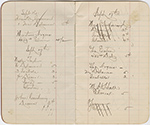 |
Pleasant Valley Winery. Notebook, 1889. [zoom] This notebook lists the names of growers and the varieties of grapes they grow. The numbers indicate weight of the harvested grapes in tons and pounds and the price in cents paid per pound. Of note is the name of grape grower Walter Taylor, who founded Taylor Wine Company in Hammondsport, N.Y. Large companies like Pleasant Valley and Taylor could press 100 tons of grapes a day. |
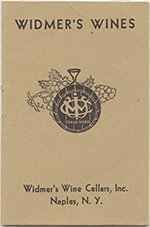 |
Widmer Wine Cellars. Bunch count booklets, ca. 1959. [zoom] | Additional images: 
These booklets show grape varieties and their various productivity levels at Widmer vineyards. |
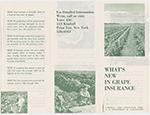 |
“What’s New in Grape Insurance.” Brochure, 1968. [zoom] To help farmers recover from poor growing seasons or other damage to their crops, the U.S. Department of Agriculture offered crop insurance. |
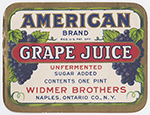 |
Grape Ephemera. [zoom] | Additional images:      
Plain grape juice and wine are just a few of the products that wineries have made with their grapes. |
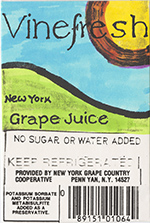 |
Vinefresh. Brochure and Label Proof, 1985. [zoom] | Additional images:  
During the mid 1980s, the prices of New York State grapes plummeted, as supply far outweighed demand. Searching for a way to use their oversupply of grapes, New York State grape growers came up with Vinefresh pink grape juice. This clever product initially sold well, but in the end could not compete with less expensive orange juice. |
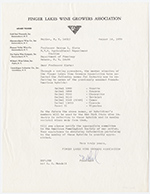 |
Finger Lakes Wine Growers Association. Letter to George Slate, August 14, 1970. [zoom] While a particular grape variety is under development, it is typically given a name and identification number that associates it with its breeder. Once the variety has been deemed worthy of public release, it is given an additional common name that a consumer can understand. This letter announces several new common grape names. The naming process is not always without controversy. For instance, the Seibel 9549 grape is named “Cameo” in this letter. The name did not gain enough support from the wider grape community, and the grape is now known as De Chaunac. The letter also mentions two other well known varieties: Chancellor and Vignoles. |
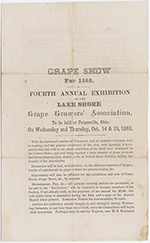 |
Grape Show Fourth Annual Exhibition. Flyer, 1868. [zoom] |
 |
Grape Crate Labels, ca. 1930. [zoom] | Additional images:   
|
 |
Welch’s Grape Juice Company. Photograph. Westfield, N.Y., ca. 1930. [zoom] Image courtesy of Lee Library, New York State Agricultural Experiment Station. |
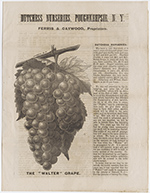 |
Dutchess Nurseries. Promotional flyer, 1868. [zoom] |
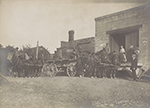 |
Grape Delivery to Naples Valley Wine Cellars. Photograph. Naples, N.Y., ca. 1920. [zoom] In the days before the automobile, grapes were hauled in horse carts. Each tray holds about 40 pounds of grapes. Naples Valley Wine Cellars was purchased by Widmer Wine Cellars in 1941. |
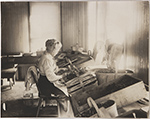 |
Packing and Sorting Table Grapes. Photograph, ca. 1920. [zoom] Image courtesy of Lee Library, New York State Agricultural Experiment Station. |
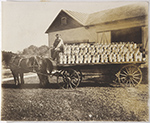 |
Grape Crates on Horse Cart. Photograph. Fredonia, N.Y., ca. 1920. [zoom] In the early years, the sorting and packing of table grapes took place in warehouses. This process later moved into the vineyard, and now takes place as the grapes are picked or harvested. Image courtesy of Lee Library, New York State Agricultural Experiment Station. |